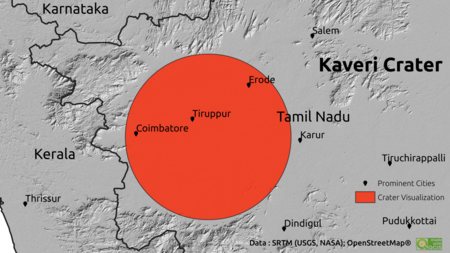Earth:Kaveri Crater
Kaveri Crater is an area identified by scientists in India which appears to have been created by an asteroid impact that occurred around 800 to 550 million years ago. The area lying between Nilgiris and Kodaikanal is in the southern peninsular India. A study indicated that the Kaveri crater has a diameter of 120 kilometres. Because of the size of the crater, Kaveri crater can only be visualized through satellite images. The crater is the fourth largest crater in the world.
The crater
The region to the east of Palghat gap is of low elevation and nearly circular in shape. It forms a part of the Kaveri river basin. The predominantly gneissic terrain is surrounded by the charnockitic hill ranges, prominent among which are Nilgiris and Biligiriranga Hills to the north; and Anaimalai and Kodaikanal to the south. The charnockite massifs have a steep slope facing the circular feature and a gentler slope in the opposite direction. Fractures, faults and shear zones are noticed in many parts. The Bouguer anomaly in the gneissic terrain is elliptical in shape and positive, relative to the surrounding elevated region. The magnetic contours are also elliptical and the magnetic basement is deeper by about one kilometer compared with regions in the periphery. The shallow seismic velocity picture from Chennimalai to Palani indicates a graben structure. The velocity structure also depicts a 4-5 kilometer Moho up-warp near Chennimalai. Junction between the gneissic and charnockitic terrain and even beyond is marked by the presence of pseudotachylites and breccia. Field and petrographic studies indicate presence of suevite, planar deformation features (PDF), planar fractures, diaplectic glass of quartz and plagioclase and spherical inclusion in suevite. These evidences taken together point to an extraterrestrial impact that created a crater of approximately 120 kilometer in diameter. Several lines of indirect evidences point to Neoproterozoic age for the impact.[1][2][3]
References
- ↑ Kumar, R. Krishna (19 January 2019). "Did an asteroid hit south India millions of years ago?". https://www.thehindu.com/sci-tech/science/did-an-asteroid-hit-south-india-millions-of-years-ago/article26039498.ece. Retrieved 29 January 2019.
- ↑ "Kaveri Crater – An Impact Structure in the Precambrian Terrain of Southern India". https://www.researchgate.net/publication/320245531. Retrieved 29 January 2019.
- ↑ Subrahmanya, K. R.; Prakash Narasimha, K. N. (1 October 2017). "Kaveri crater â€" an impact structure in the recambrian terrain of Southern India". Journal of the Geological Society of India 90: 387–395. doi:10.1007/s12594-017-0733-5.
External links
- Earth Impact Database – List of confirmed earth impact sites at the Planetary and Space Science Centre, University of New Brunswick
- Impact Database (formerly Suspected Earth Impact Sites list) maintained by David Rajmon for Impact Field Studies Group, USA




